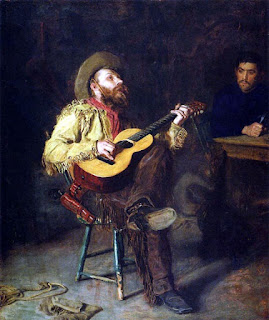Absurd Halite Bacteria Claim by Evolutionists
A few weeks back, Joe Nexnelsrent visited the Darwin Ranch for a symposium, then stayed around a spell to talk about other evolution things. He also tried to sing the song of his people about life existing embedded in halite for millions of evolutionary years.
It seems to this child that people, whether scientists or the public in general, have the right to know the truth. Researchers who make claims in the increasingly untrustworthy peer review process should have to give credible scientific information to support those claims. Also, the press should perform due diligence and ask questions instead of being mindless drones.
 |
| Home Ranch, Thomas C. Eakins, 1892 |
The latest record-breaking claim for preserved life is so off the charts that even one staunch evolutionary biologist calls it “outlandish” and “bombastic.” But the GSA (Geological Society of America) published it, so it must be true, right? It passed peer review. Isn’t that the gold standard for scientific credibility? You can laugh now – or later, after you read the quote below.. . .The paper in the GSA’s prestigious journal Geology 6 May 2022 is titled “830-million-year-old microorganisms in primary fluid inclusions in halite” and is authored by Sara I. Schreder-Gomes, Kathleen C. Benison, Jeremiah A. Bernau.These three claim that little round objects they looked at in their microscopes are cells, and they might still be alive! How do they know they are 830 million years old? Because they are found in 830-million-year-old rocks. How do they know the rocks are that old? Because that’s what the evolutionary timeline requires. Darwin, you see, needs lots of time for lucky accidents to add up and create brains from lifeless chemicals.
To read the whole thing and see why thinking creationists are making Darwin sad, see "News Media Swallow 830 Million Year Old Life Claim." ADDENDUM: I wrote this up several days before it was published on the weblog. The day of publication, CMI released their perspective. To read that, click on "'830-million-year-old' microorganisms?"
